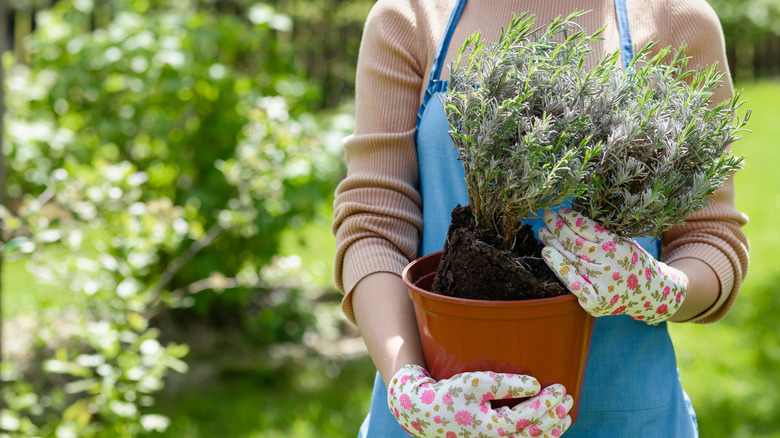Boost Lavender Blooms With A Simple Soil Addition You Can Easily Mix In
Thriving lavender bushes in the garden rarely go unnoticed, even by non-gardeners. You smell them before you see them, and their purple stems billow in the breeze, begging for a gentle touch. They're also beloved for their medicinal and culinary purposes, and how they call to mind idyllic lavender fields in France. If you have been dreaming of your own lavender field (or, more realistically, just a shrub or two), it's beneficial to first consider the best ways to plant lavender.
One of the most important details to keep in mind is the plant's ideal growing conditions. Lavender plants prefer soil with a neutral pH of 6.5 to 7.5, and are hardy to USDA Hardiness Zones 5 to 8. Since it is native to southern Europe, think dry heat and rocky soil. Most importantly, lavenders need well-drained soil. Letting it sit in wet soil will likely lead to root rot, one of the common problems with lavender plants. If this is the case, the plant will likely begin wilting, and its leaves will turn yellow or die.
An easy way to ensure a healthy well-drained lavender plant is to mix pea gravel into the soil. Choosing pea gravel over another type of soil amendment, like peat moss or coconut coir, improves the soil's ability to drain — rather than retain — water, like some other materials do. Aim for 50% gravel with 50% soil, especially if you're working with dense clay-like soil.
Tips for a healthy lavender plant
This technique is beneficial whether you're putting the lavender into the ground or in a container with a drainage hole at the bottom. If you're growing lavender in the ground, a raised bed, mound, or slope offer better drainage than flat terrain. Test your soil's drainage with this simple method. Dig a hole measuring about 12 inches wide and deep. Fill the hole with water and let it sit overnight. Refill again the following day. Then, track the number of inches per hour that the water has drained. A rate of 2 inches per hour is ideal for plants with average draining needs. If your garden soil absorbs water at a rate of less than an inch per hour, your lavender likely needs to be amended with gravel.
If you have extra pea gravel, use it as a mulch around the crown of the lavender instead of wood mulch, which often is used to lock in moisture in the soil. Pea gravel will soak up the sun's rays, reflecting warmth back to the lavender and keeping the soil dry around the plant. Lay down only a thin layer of gravel to avoid retaining excess moisture that can harm the plant.
Another tip to encourage lavender blooms is to hold back on fertilizing, especially if the plant was started in soil rich in organic matter. In the case with lavenders and the effect of fertilizing on plant growth, fertilizing encourages the plant to direct energy into foliage rather than blooms. However, if you do want to give your plant extra nutrients, choose a fertilizer that is low in nitrogen.

